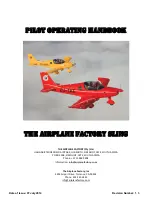
9
ENGLISH
and accelerate smoothly for the launch.
During a forward launch we advise to NOT use the power launch
technique. During the inflation the power should be progressively
applied once the wing is half way up. Applying the power too early
may inhibit the inflation characteristics of the center part of the
wing, causing the wing tips to come up faster.
NOTE: The trimmers should be set to the lower white line
position for better inflation behaviour during take-off. This
is especially important in light winds and/or at high alti-
tudes.
IMPORTANT: Lay out the wing in a pronounced arc with the
center of the wing higher than the tips. DO NOT apply the
power too early.
Reverse Launch -Light to Strong Winds
Lay out your Viper 3 as you would for the forward launch. However,
this time face the wing, and attach the risers in the correct manor
(half a turn in each riser, and crossed in the direction you want to
turn). Now you can pull up the Viper 3 by its A-risers. Once the
wing is overhead, brake it gently, turn and launch.
In stronger winds, be prepared to take a few steps towards the
glider as it inflates. This will take some of the energy out of the
glider and it will be less likely to over-fly you. Once stable and
above your head apply progressive power and accelerate smoothly
for a controlled take off.
IMPORTANT: Never attempt to take off with a glider that is
not fully inflated, directly overhead or if you are not fully in
control of the pitch/roll of the wing.
Practice ground handling and launching as much as possible! It is
great fun, and will give you a much better feel for your Viper 3s
flight characteristics. It will also improve your overall enjoyment of
flying by making your launches easier and safer.
Launching
Your Viper 3 will launch with either the forward or reverse launch
techniques. It is best to adjust the trimmers to the lower white line
position.
When taking off under power, make sure there is enough clear
space upwind of you to launch and climb out safely, avoiding trees,
power lines and any other obstacles that may affect you should
you have a power failure. Always fly with a safety margin so that
power failures do not leave you compromised. You should always
be able to glide power off to a suitable landing place.
Once clipped in, and you have gone through the take-off check list
(above), stand central to the wing to ensure an even and progres
-
sive inflation. Whilst inflating your wing, you should hold both of
the A risers on each side.
Run in an upright position so that the motor is generating forward
thrust, do not lean too far forward otherwise the power of the
motor will attempt to push you into the ground! When you have
enough airspeed a gentle application of brake will help you lift off.
Do not stop running until your feet have left the ground and you
are sure of a safe climb out.
Forward Launch - Nil to Light winds
When the wind is favourable, move forward positively: your lines
should become tight within one or two steps. The Viper 3 will im
-
mediately start to inflate. You should maintain a constant pressure
on the risers until the wing is overhead.
Do not pull down or push the risers forward excessively, or the
leading edge will deform and possibly collapse making taking-off
more difficult and potentially dangerous.
Move smoothly throughout the entire launch, there is no need to
rush or snatch at it. You should have plenty of time to look up and
check your canopy before committing yourself. Once you are happy
that the Viper 3 is inflated correctly, progressively apply full power






































